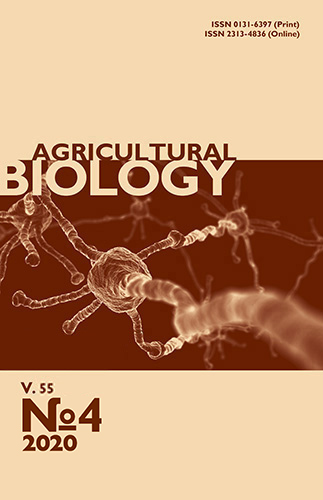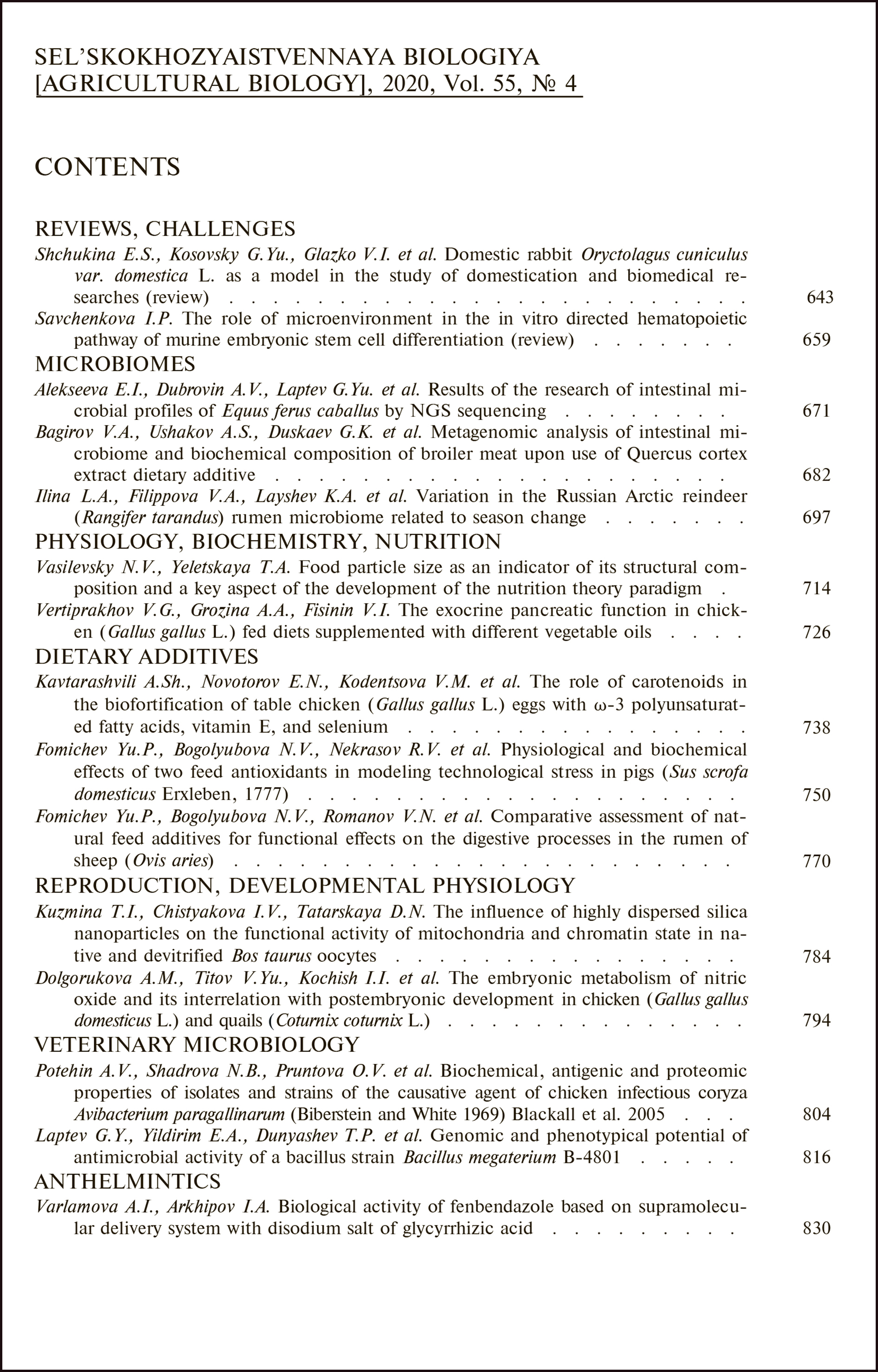doi: 10.15389/agrobiology.2020.4.714eng
UDC: 636.2:591.132:57.01
FOOD PARTICLE SIZE AS AN INDICATOR OF ITS STRUCTURAL COMPOSITION AND A KEY ASPECT OF THE DEVELOPMENT OF THE NUTRITION THEORY PARADIGM
N.V. Vasilevsky, T.A. Yeletskaya
Institute of Animal Science of National academy of agrarian sciences of Ukraine, 3, vul. 7-i Gvardeiskoi Armii, Kharkov, 61120 Ukraine, e-mail vasilevskii.n@mail.ru (✉ corresponding author), eletskatat@zandex.ru
ORCID:
Vasilevskiy N.V. orcid.org/0000-0002-7437-2910
Yeletskaya T.A. orcid.org/0000-0001-8980-6972
Received October 8, 2019
The using of modern feed-preparation machines and new technologies for the preparation and feeding of rations in animal husbandry has exacerbated the problem of the ratio in food of relatively large particles that capable to support the necessary motility of the digestive tract and relatively small ones, which provide high consumption of dry matter and its digestibility. In the presented work, we were the first to obtain data about the relationship between the particle size of the diet, the contents of the gastrointestinal tract and the feces of cattle. Based on the determination of the average particle size and dry matter content, a method for assessing the structure of feed has been proposed. The concepts of the informational component of food and the definition of rationed feeding have been introduced into the paradigm of nutrition theory. The aim of the work was to study the impact of the particle size of the diet on the particle size of the contents of the gastrointestinal tract and feces of cattle; to assess the relationship of these indicators with the digestibility of the main groups of nutrients; to develop a methodological approach to rationing the diet structure; to supplement the theory of rationed feeding with the necessary concepts. The studies were carried out at the Institute of Animal Science of National academy of agrarian sciences of Ukraine in 2017-2019 on two heifers (Bos taurus taurus) of the Ukrainian red-and-white breed with a live weight of 350 kg fitted with a duodenal lockable cannula of the beginning of the duodenum and a large-diameter rumen cannula. The animals were fed twice a day (at 8 a.m. and 5 p.m.) in equal shares. Chyme flux was measured during 9 h after morning feeding. The intake of chyme into the duodenum was measured within 14 days (n = 6). The measurements were interrupted for 1-2 days to give the animals rest. Samples of the contents of the rumen were collected through a cannula with a 100 mm diameter from the middle part of the rumen mat in triplicate with a 3 h interval between morning and evening feeding. The experiments were designed according to the balance test methodology with simultaneous assessment of the duodenal chyme flux and sampling of the rumen contents, duodenal chyme and feces. The main diet consisted of hay, silage, concentrates and provided the maintenance of the basal metabolism. The other rations were obtained by replacing one or two components of the main ration with additional amounts of the remaining components in an amount that was equal to the dry matter value of the interchangeable feed. The average particle size of the feed particles was determined by the arithmetic weighted average method by manual parsing and dry sieving, and the selected biological samples by the wet sieving method. The metabolic energy of the rations was calculated. It was found that the average particle size of rumen, chyme and feces decreased with an increase in the average particle size of the diet. The average particle size of the rumen (8.68±0.49 mm, n = 31) was an order of magnitude higher than the average particle size of the duodenal chyme and feces, that indicates the most intense crushing of feed in the proventriculus. The average particle size of feces (1.09±0.06 mm, n = 19, 0.1> p> 0.05) exceeded the average particle size of the duodenal chyme (0.99±0.05 mm, n = 31), that is indicative of the predominant digestion of the small fraction in the intestine and the formation of feces from the large fraction of the chyme. The value of feed structure in our studies was 0.12-0.92 kg·m/day vs. 0.033-0.062 kg·m/day for the contents of the rumen, 0.0031-0.0057 kg·m/day for duodenal chyme, and 0.0019-0.0028 kgʺm/day for feces. A relationship between the structure of the diet, the availability of crude protein for digestion in the intestine and the size of feces particles was revealed, that theoretically suggests the possibility of assessing the state of digestive processes which based on the granulometric parameters of feces. The obtained data allow us to discuss the factors, affecting feed (and food) digestion and assimilation, which cannot be evaluated in a classical balance experiment by the difference in feed consumption and excretion. It has been proposed to collectively denote these factors as an information component which should be incorporated to express the concept of complex feed (food) structure. The information component is represented in part by various biologically active substances that are ingredients of the feed itself and/or products of the gastrointestinal microorganisms. Another part comprises physical factors, such as the physical parameters of food (temperature, humidity, particle size and stiffness), and non-feed factors (frequency and regularity of feeding, phased feeding, sound, light and other wave effects). We suggest the definition for rationed nutrition as a process of matter and information exchange between the external environment and the body, which ensures welfare and productive life.
Keywords: average particle size of food, structure of food, informational component of food, normalized feeding, theory of nutrition.
REFERENCES
- Moya D., Mazzenga A., Holtshausen L., Cozzi G., González L.A., Calsamiglia S., Gibb D.G., McAllister T.A., Beauchemin K.A., Schwartzkopf-Genswein K. Feeding behavior and ruminal acidosis in beef cattle offered a total mixed ration or dietary components separately. Journal of Animal Science, 2011, 89(2): 520-530 CrossRef
- Kharitonov E. Myasnoe i molochnoe skotovodstvo, 2010, 1: 16-17 (in Russ.).
- Tylutki T.P., Fox D.G., Durbal V.M., Tedeschi L.O., Russell J.B., Van Amburgh M.E., Overton T.R., Chase L.E., Pell A.N. Net sarbohydrate and protein system: a model for precision feeding of dairy cattle. Animal Feed Science and Technology,2008, 143(1): 174-202 CrossRef
- Hutjens M.F. Is a one TMR approach right? Western Dairy Management Conference. Reno, 2012: 195-190.
- Fahey G.C., Novotny L., Layton B., Mertens D.R. Critical factors in determining fiber content of feeds and foods and their ingredients. Journal of AOAC INTERNATIONAL,2019, 102(1): 52-62 CrossRef
- Beauchemin K.A., Rode L.M., Eliason M.V. Chewing activities and milk production of dairy cows fed alfalfa as hay, silage, or dried cubes of hay or silage. J. Dairy Sci., 1997, 80(2): 324-333 CrossRef
- Beauchemin K.A., Yang W.Z. Effects of physically effective fiber on intake, chewing activity, and ruminal acidosis for dairy cows fed diets based on corn silage. J. Dairy Sci., 2005, 88(6): 2117-2129 CrossRef
- Woolpert M.E., Dann H.M., Cotanch K.W, Melilli C., Chase L.E., Grant R.J. Management practices, physically effective fiber, and ether extract are related to bulk tank milk de novo fatty acid concentration on Holstein dairy farms. J. Dairy Sci., 2017, 100(6): 5097-5106 CrossRef
- Weiß H. von J., Pabst W., Granz S. Tierproduktion. Stuttgart, 2011.
- Aliev A.A. Noveishie operativnye metody issledovaniya zhvachnykh zhivotnykh [The latest surgical techniques in research studies of ruminants]. Moscow, 1985 (in Russ.).
- Vlіzlo V.V., Fedoruk R.S., Ratich І.B., Vіshchur O.І., Sharan M.M., Vudmaska І.I., Fedorovich Є.Sh., Ostapіv D.D., Stalai P.V., Buchko O.M., Gunchak A.V., Saliga Yu.T., Stefanishin O.M., Gevkan І.І., Lesik Ya.V., Sіmonov M.R., Nevostruєva І.V., Khomin M.M., Smolyanіnov K.B., Gavrilyak V.V., Kolіsnik G.V., Petrukh І.M., Broda N.A., Luchka І.V., Koval'chuk І.І., Kropivka S.I., Paranyak N.M., Tkachuk V.M., Khrabko M.І., Shtapenko O.V., Dzen' Є.O., Maksimovich І.Ya., Fedorovich V.V., Yus'kіv L.L., Dolaichuk O.P., Іvanits'ka L.A., Sіrko Ya.M., Kistsіv V.O., Zagrebel'nii O.V., Sіmonov R.P., Stoyanovs'ka G.M., Kirilіv B.Ya., Kuzіv M.І., Maior Kh.Ya., Kuz'mіna N.V., Talokha N.І., Lіsna B.B., Klimishin D.O., Chokan T.V., Kamіns'ka M.V., Kozak M.R., Olіinik A.V., Golova N.V., Dubіns'kii V.V., Іskra R.Ya., Rіvіs I.F., Tsepko N.L., Kishko V.І., Oleksyuk N.P., Denis G.G., Slivchuk Yu.І., Martin Yu.V. Laboratornі metodi doslіdzhen' u bіologії, tvarinnitstvі ta veterinarnіi meditsinі: Dovіdnik /Za red. V.V. Vlіzla. Spolom, L'vіv, 2012.
- Vasilevskii N.V., Eletskaya T.A., Greben' L.G., Berestovaya L.E. Problemy biologii produktivnykh zhivotnykh, 2017, 2: 88-100 (in Russ.).
- Nehring K., Schiemann R., Hoffman L. A new system of energetic evaluation of food on basis of net energy for fattening. In: Energy metabolism of farm animals. Oriel Press, London, 1969.
- National Research council. Nutrient requirements for dairy cattle: seventh revised edition. The National Academies Press, Washington DC,2001: 381-333 CrossRef
- Vasilevskii N., Eletskaya T., TSyupko V., Berestovaya L. Vliyanie tekhnologii skarmlivaniya kormov i urovnya syrogo proteina v ratsione na perevarimost' pitatel'nykh veshchestv u korov. Problemy biologii produktivnykh zhivotnykh, 2013, 1: 67-74.
- Pokrovskii A.A. Besedy o pitanii [Nutritional conversations]. Moscow, 1964 (in Russ.).
- Pokrovskii A.A. Metabolicheskie aspekty farmakologii i toksikologii pishchi [Metabolic aspects of food pharmacological and toxicological effects]. Moscow, 1979 (in Russ.).
- Ugolev A. M. Enterinovaya (kishechnaya gormonal'naya) Sistema [Enteric (intestinal hormonal) system]. Leningrad, 1978 (in Russ.).
- Ugolev A.M., Labusheva M.A., Vakhrushev Ya.M. Fiziologicheskii zhurnal SSSR im. I.M. Sechenova, 1989, 75(5): 609-618 (in Russ.).
- Medvedev A.Yu. Usovershenstvovanie energosberegayushchei tekhnologii proizvodstva govyadiny v molochnom skotovodstve. Doktorskaya dissertatsiya [Improvement of energy-saving technology for beef production in dairy farming]. Lugansk, 2015 (in Russ.).
- Leibina T.I. Izvestiya Samarskoi gosudarstvennoi sel'skokhozyaistvennoi akademii, 2015, 1: 171-174 (in Russ.).
- Meena K., Khazai N.B., Ziegler T.R., Nanes V.S., Abrams S.A., Tangpricha V. Vitamin D-mediated calcium absorption in patients with clinically stable Crohn’s disease: a pilot study. Mol. Nutr. Food Res., 2010, 54(8): 1085-1091 CrossRef
- Kaushik R., Sachdeva B., Arora S., Kapila S., Wadhwa B.K. Bioavailability of vitamin D2 and calcium from fortified milk. Food Chemistry,2014, 147: 307-11 CrossRef
- Nelson C.D., Powell J.L., Price D.M., Hersom M.J., Yelich J.V., Drewnoski M.E., Bird S.L., Bridges G.A. Assessment of serum 25-hydroxyvitamin D concentrations of beef cows and calves across seasons and geographical locations. Journal of Animal Science,2016, 94(9): 3958-3965 CrossRef
- Holcombe S.J., Wisnieski L., Gandy J., Norby B., Sordillo L.M. Reduced serum vitamin D concentrations in healthy early-lactation dairy cattle. Journal of Dairy Science, 2018, 101(2): 1488-1494 CrossRef
- Ugolev A.M. Teoriya adekvatnogo pitaniya i trofologiya [The theory of adequate nutrition and trophology]. Leningrad, 1991 (in Russ.).
- Vasilevskaya L.S. Rossiiskii zhurnal gastroenterologii, gepatologii, koloproktologii, 2001, 11 (4-prilozhenie № 14 Materialy XVI sessii Akademicheskoi shkoly-seminara imeni A.M. Ugoleva «Sovremennye problemy fiziologii i patologii pishchevareniya», Pushchino-na-Oke, 14-17 maya 2001 goda): 148-155 (in Russ.).
- Sandor S., Yoshida M., Filakovszky J., Juhasz G. «Stress» is 80 years old: from Hans Selye original paper in 1936 to recent advances in gi ulceration. Current Pharmaceutical Design,2017, 23(27): 4029-4041 CrossRef
- Robert L Spencer R.L., Deak T. A users guide to HPA axis research. Physiology & Behavior, 2017, 178: 43-65 CrossRef
- Dunn A.J., Berridge C.W. Physiological and behavioural responses to corticotrophin-releasing factor administration: is CRF a mediator of anxiety or stress responses? Brain Research Reviews, 1990, 15(2): 71-100 CrossRef
- Koob G.F. Corticotropin-releasing factor, norepinephrine and stress. Biological Psychiatry, 1999, 46(9): 1167-1180 CrossRef
- Fisher A.D., Crowe M.A., Prendiville D.J., Enright W.J. Indoor space allowance, effects on growth, behaviour, adrenal and immune responses of finishing beef heifers. Animal Science, 1997, 64(1): 53-62 CrossRef
- Fisher A.D., Verkerk G.A., Morrow C.J., Matthews L.R. The effects of feed restriction and lying deprivation on pituitary-adrenal axis regulation in lactating cows. Livestock Production Science, 2002, 73(2-3): 255-263 CrossRef
- Munksgaard L., Ingvartsen K.L., Pedersen L.J., Nielsen V.K.M. Deprivation of lying down affects behaviour and pituitary-adrenal axis responses in young bull. Acta Agriculturae Scandinavica, Section A — Animal Science,1999, 49(3): 172-178 CrossRef
- Munksgaard L., Herskin M.S., Lovendahl P., Andersen J.B. Effects of nutrition on stress reactivity. In: Ruminant physiology. Digestion, metabolism and impact of nutrition on gene expression, immunology and stress. K. Sejrsen, T. Hvelplund, M.O. Nielsen (eds.). Wageningen Academic Publishers, 2006: 511-525.
- Vasilevskii N.V. Problemy biologii produktivnykh zhivotnykh, 2015, 2: 67-79 (in Russ.).












